
The theme of Puerto Rican Liberation has been central to my creative practice since its inception in the mid 1990s. This gallery presents a selection of Puerto Rican liberationists and freedom fighters whose portraits I created between 1994 and 2021. The cluster of islands known as the archipelago of Borikén (name of its Isla Grande or Big Island) were invaded on November 19, 1493, by Columbus and his fleet of conquerors. The main island was renamed San Juan Bautista by the Spaniards, and later Puerto Rico. Invaded again by the US Navy on July 25th, 1898, Puerto Rico continues to be a colony of the US. Our people and lands, and all colonized territories (including reservations) across the planet, have a natural right to liberation. Statehood is not a decolonial option. To decolonize is to practice the highest expression of self-determination, with the freedom to recapture our original essence and evolve in that essence. Statehood would absorb and work to displace and replace our Boricua-ness, our identity and essence, como “lo que le pasó a Hawai’i.”
Today we witness the escalation of land grabs across our archipelago, the exploitation of our resources, the destruction of our environment, the deforestation of our coastlines for development—a threat that leaves us more vulnerable to flooding and coastal erosion in these times of climate-change. So-called development has also literally flattened hills in our northern karst region, home to caves and aquifers that are supposedly protected natural resources. These are flattened by machines and trucks to erect foreign shopping centers and other corporate-capitalist ventures. We see the displacement and disfranchisement of Indigenous communities, as in Hawai’í. We continue to suffer the effects of a deliberate colonial dependence on food imports coupled with US cabotage laws, making our food more expensive than in the US, then combined with a tax higher than any in the states. We continue to battle through telecommunications injustice and the disaster of incessant power outages from our energy supplies privatized and distributed by an outside corporation. Whereas many see this as a healing, restful vacation destination, those living here continue to endure the decline of education, mass school closures, dwindling medical care, less job opportunities, sky-rocketing real estate pricing us out, and more.
After two decades working as an artist and activist around Puerto Rican liberation, in 2014 I left New York City, where I was born and raised, and moved to my parents’ birthplace of Borikén, committing body, mind, and spirit, to this work. Rematriating Borikén has broadened my perspective on liberation, the pursuit of liberation and the practice of liberation that we can embody daily.
Follow the Leader, 1998 (Pedro Albizu Campos). Yasmin Hernandez. Oil on canvas, 30" x 24". Living and working in Philadelphia during the centennial, I contemplated the invasion of my nation within sites like the Liberty Belly, altars to the independence of the imperialist. I began envisioning altars to our own liberation. This piece is born from that envisioning. The title always reminds me of the rap "Follow the Leader" by Rakim (...Remember, you're not a slave 'Cause we was put here to be much more than that/ But we couldn't see it because our mind was trapped.) I returned to New York in 1999 during the escalation of the movements for peace and justice on Vieques and the excarceration of our Puerto Rican Political Prisoners.
"Soldadera: Lolita Lebron:" 2021, Acrylic on Brown Paper, 55”x36”. Contemplating ten years since my Soldaderas mural, I began this series of women fighting continued US imperialism. Lolita Lebrón Sotomayor was born on November 19, historic day of Columbus’ 1493 landing. Born in the mountain town of Lares, site of the 1868 revolution, she was destined to be a Soldadera. A member of the Puerto Rican Nationalist Party, Lolita is most known for leading an armed revolt at the US Capitol on March 1st, 1954, for which she was held for 25 years as a Political Prisoner of the US on sedition charges.
"Dignity/ Dissent" (Pedro Albizu Campos) 2017, Yasmin Hernandez. Acrylic on canvas, 12" x 12". Created for the CitiCien Defend PR exhibition, commemorating 100 years of the Jones Act that imposed US citizenship on Puerto Rico, strategically the same year the US entered WWI, enabling the draft of our men. Nationalist Party leader Pedro Albizu Campos is pictured here in his US Army uniform that same year and later in a gesture representing his fierce fight against US colonialism. The background image in black and white is of the Puerto Rican Nationalist Party flag.
"La Libertad" (Oscar López Rivera) 2016. Yasmin Hernandez. Mixed media on canvas, 24" x 36". Created for the traveling exhibition, Una Sola Voz which brought together over 50 artists in support of the release of Puerto Rican Political Prisoner Oscar Lopez Rivera, pictured here among many other heroes that have defended Puerto Rico's natural right to liberation. Included is an excerpt of our original revolutionary anthem, La Borinqueña by Lola Rodríguez de Tío. "Vamonos ya que nos espera ansiosa la Libertad".
"Dedebt/ Decolonize" 2017. Yasmin Hernandez. Mixed media on canvas, 18" x 14". Commissioned for Occupy Museum’s Debt Fair installation at the 2017 Whitney Biennial. The Puerto Rican archipelago is presented within a nebula. From the main island emerges the face of Oscar López Rivera, held as a Political Prisoner of the US for 35 years on sedition charges for participating in the Puerto Rican liberation struggle. His sentence was commuted by US President Obama 1 week after I completed this work. The work was still on exhibit at the Whitney when Oscar was released in May of 2017.
"Eso que llamamos la libertad", 2016. Yasmin Hernandez. Acrylic on canvas, 30" x 24". Portrait of artist, poet, professor, former Puerto Rican political prisoner Elizam Escobar. I included a quote I heard during his presentation at a political prisoner conference in Mayagüez: "That which we call freedom is not a state of being, it is a practice." I painted him dressed in a nebula to reference the transcendence and liberatory practice embodied by Elizam in his art, actions, and words. Elizam left this realm in January of 2021.
“Las Cuatro Esquinas” 2016. Yasmin Hernandez. Acrylic on recycled palette wood. Detail of collaborative installation at the former Galería Betances, Mayagüez, PR. This image was part of a tribute exhibition to 19th century Puerto Rican Revolutionary, Abolitionist, Dr. Ramón Emeterio Betances. It includes a recreation of the Lares flag that he designed for the September 23rd, 1868 revolution that he authored representations of enslaved people who were emancipated on March 22nd, 1873, thanks to his abolition work.
"Esas estrellas" 2015. Yasmin Hernandez. 2015, Acrylic on burlap, approx 30" x 39" Tribute to Rafael Cancel Miranda, former political prisoner who served 25 years on sedition charges for his participation in an armed revolt in Washington DC in 1954. The quote comes from the dedication of his book, Mis Dioses llevan tu Nombre (2000). “Hay estrellas en el cielo que no vemos porque no las buscamos. La razón de este libro es ayudar a encontrar a esas estrellas en nuestros propios cielos.” (There are stars in the sky that we do not see because we do not seek them. The reason for this book is to help find those stars in our own skies.)
"Somos Muchos" (Oscar López Rivera) Yasmin Hernandez. 2015, Mixed media on canvas, 30" x 24". Commissioned for the University of Puerto Rico-Mayagüez’ conference, Luchas de Ayer, Ahora y Siempre (?) on Puerto Rican political prisoners past and present. Oscar López Rivera is presented among a selection of ancestors who sacrificed their lives for the liberation of Puerto Rico. Within his portrait we see a selection of the comrades who, like him, have served as political prisoners for wanting the freedom of their country.
“Quienes Somos/ Who we are”. Superimposed over the "Somos Muchos" painting are the names of all the Puerto Rican freedom fighters collaged into this portrait of former Puerto Rican political prisoner of 35 years, Oscar López Rivera.
"Querer ser libre" (Dylcia Pagán) 2006. Yasmin Hernandez. Acrylic, seashells and peacock feathers on canvas. 24" x 36". This portrait was commissioned for a tribute to former Puerto Rican political prisoner Dylcia Pagán by the Bronx Academy of Arts and Dance (BAAD). My dear friend and mentor, I painted her as I remembered during an afternoon we spent at the sea, behind her home in Loíza. This portrait hung in her living room until her unexpected transition into ancestorhood in 2024. The quote is of Ramón Emeterio Betances, (The desire to be free is to begin being free). I am ever grateful to the freedom she embodied and modelled for us all and to the fierce love she shined on me and so many of my generation, and beyond.
"Raising Revolution" 2004, (Pedro Albizu Campos). Yasmin Hernandez. Mixed media on canvas, 48" x 30" Collection of the Center for Puerto Rican Studies. This portrait of Pedro Albizu Campos shows him in his US Army uniform, but the piece itself focuses on many revolutionaries who received their training in either the US military or US schools. Puerto Ricans were made citizens of the US in 1917, strategically the year the US entered WWI. However, as a colony, Puerto Rico cannot vote in presidential elections, having no say in the commander of chief of the many who serve the US armed forces. Many have subverted this military training, using it instead to inform their liberation work.
"Pesar y orgullo" 2004. Yasmin Hernandez. Mixed media on canvas, 48" x 24". This portrait of Puerto Rican Nationalist Lolita Lebrón shows her at the time of her arrest having led an armed protest at the US Capitol on March 1, 1954. She is nude with prison bars glazed over her flesh, marking the double standard imposed on women revolutionaries and the violation of their bodies as political prisoners. The collage features revolutionary women of color. This piece was in response to the 2004 Washington Post Magazine article with Lolita’s image on the cover and the title: When Terror Wore Lipstick. I was asked to contribute artwork to that article. I asked for assurance that she would not be presented in a negative light then was mortified when it was published with that cover. In a public chat with the author, people criticized Lolita for abandoning her children, making references to domestic responsibilities that male revolutionaries are never challenged on. With this work, I contemplated her body as a cell, a site of oppression that the empire wages violence on.
"Sin Miedo" (Para Lolita). 2003. Yasmin Hernandez. Acrylic on canvas, 36" x 18". Collection of Poet/ Author Luivette Resto. This is another portrait of a fearless Lolita Lebrón at the time of her arrest on March 1, 1954 after leading an armed protest over a meeting of the US House of Representatives, demanding a Free Puerto Rico. Lolita & her comrades served 25 years before US President Jimmy Carter (the most honest US president) commuted their sentences in 1979.
Albizu Elevao. 2006. Yasmin Hernandez. Acrylic on Burlap, 72" x 39 1/2". “Ay como lo escupieron/ Como lo empujaron/ Como lo llevaron a crucificar....” -excerpt from the salsa song "El Todopoderoso" (Oh how they spit on him, how they pushed him, how they took him to crucifixion). This work references the radiation experiments that the US government conducted on the father of Puerto Rican Nationalism Pedro Albizu Campos. These were secretly administered in the form of bright white or multicolored lights that would flash in his cell & in his hospital room. Albizu suffered burns & seizures, ultimately passing from cancer in 1965. Albizu had exposed US Dr. Cornelius Rhoads who had deliberately injected cancer into Puerto Ricans. For this and other cancer and chemical experiments he conducted in the US prison system, Dr. Rhoads was named Time Magazine’s “Man of the Year” and became director of the Rockefeller Institute and the Memorial Sloan Kettering Cancer Center in New York.
“Patria Ensangrentada” (Filiberto Ojeda Ríos). 2006. Yasmin Hernandez. Acrylic on canvas, 63" x 40". Patria Ensangrentada pero jamás desecha. (Nation bloodied, but never undone). These words of Puerto Rican Nationalist poet Julia de Burgos come from her poem”23 de septiembre,” about the 1868 Lares revolution. On the same date in 2005, the FBI assassinated revolutionary leader of Los Macheteros, Filiberto Ojeda Rios, who had been in clandestinity for 15 years. 72 years-old at the time, he solely held a shoot-out with them wearing a bullet proof vest, but was left to bleed to death behind his front door from a single bullet to his clavicle, something he should have survived. The town had been under siege in the planned attack on his home in Hormigueros. No ambulances were allowed to pass.
“Independence Day,” 1998. Yasmin Hernandez. Mixed media on canvas, 6' x 4'. Created for the AmeRican Borders centennial of the US invasion of Puerto Rico exhibition at Taller Puertorriqueño in Philadelphia. This scene depicts the arrests of the 4 Puerto Rican Nationalists outside of the US capitol on March 1st, 1954, with a Puerto Rican flag glazed over the building. The background is an inverted copy of the US Constitution & the foreground, which they stand on, is an inverted copy of the US Declaration of Independence. I lived 5 blocks from Independence Hall in Philly at the time. Almost ten years after painting this, while researching the ARCHIVOS SUBVERSIVOS project at the Center for Puerto Rican Studies, I found a letter that Albizu Campos wrote to his friend Ruth Reynolds, on a torn out page of the Table of Contents of the US Constitution.
Follow the Leader, 1998 (Pedro Albizu Campos). Yasmin Hernandez. Oil on canvas, 30" x 24". Living and working in Philadelphia during the centennial, I contemplated the invasion of my nation within sites like the Liberty Belly, altars to the independence of the imperialist. I began envisioning altars to our own liberation. This piece is born from that envisioning. The title always reminds me of the rap "Follow the Leader" by Rakim (...Remember, you're not a slave 'Cause we was put here to be much more than that/ But we couldn't see it because our mind was trapped.) I returned to New York in 1999 during the escalation of the movements for peace and justice on Vieques and the excarceration of our Puerto Rican Political Prisoners.
“The Ponce Massacre”, 1997. Yasmin Hernandez. Oil, collage on canvas, 51" x 34". Part of my BFA Thesis exhibition at Cornell University, created in the underpainting/ glaze technique, this image borrows from the composition of Paul Revere's “The Bloody Massacre” of 1770, depicting the Boston Massacre leading to the American Revolution. The Ponce Massacre, took place on March 21st, 1937 in my parents' hometown, when the US colonial police chief revoked a parade permit on Palm Sunday commemorating the abolition of slavery. When the people marched anyway, the police opened fire on them killing 21 & wounding around 200.
“¿Estadista?” 1996. Yasmin Hernandez. Mixed media on canvas, 48" x 32". This is one of various flags painted on canvas with grommets. The indigenous figure of Atabey and the fetus reference the mass sterilization of Puerto Rican women. Albizu and the group of striking laborers are juxtaposed with images of the Latin Kings. As I embarked on a self-education process on our subversive history as an undergrad at the libraries of Cornell University, my cousin and uncle did the same with The Latin Kings and the Ñetas while incarcerated. This piece honors our diverse paths towards decolonization and denounces statehood as something that impedes that process.
“51st State”, 1995. Yasmin Hernandez. Oil on canvas. 48" x 37 1/2". Painted during my junior year/ BFA program at Cornell University. 51st State is technically my first portrait of the 4 Nationalists arrested in Washington on March 1st, 1954. Lolita Lebrón is the star and Rafael Cancel Miranda, Irving Flores, and Andres Figueroa Cordero are the rifles. Together they dissolve the colonial relationship of Puerto Rico and the US, hence the falling stars and the Navy blue of both flags. My earlier political works use the dark blue of the US flag and over time lighten to the sky blue used by independence supporters. The original concept of our flag, designed as an inverse of the Cuban flag in New York in the 1890s via the Puerto Rican Wing of the Cuban Revolutionary Party references the sky in its inspiration. After the 1898 invasion, our flag was darkened to resemble that of the US.
“Pedro Albizu Campos,” 1994. Yasmin Hernandez. Silkscreen on Paper, 14" x 8". This first portrait of mine of Pedro Albizu Campos was inspired by the book Prisoners of Colonialism by Ronald Fernandez. I was 19 and eagerly researching all things Don Pedro. My practice of painting in response to my self-education around suppressed Puerto Rican histories began in high school, however my introduction to this history didn’t begin with books but with the oral histories of my father. Black and white are the colors of the Puerto Rican Nationalist Party.
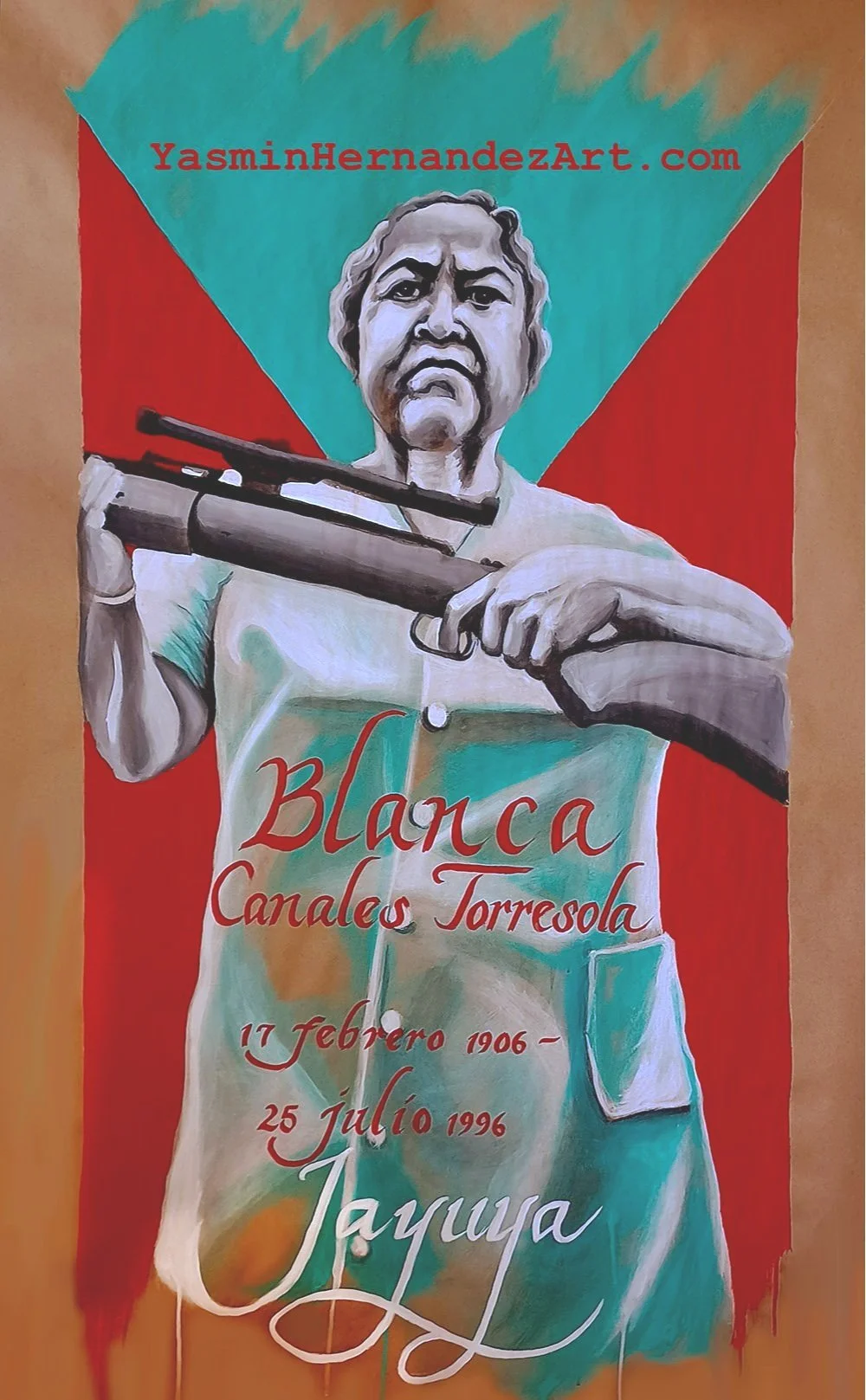
"Soldaderas: Blanca Canales", 2021. Yasmin Hernandez. Acrylic on brown paper, 48”x 36”. Ten years since my Soldaderas mural, I contemplated Puerto Rican women fighting US imperialism. Blanca Canales Torresola was the leader of the 1950 revolution that began in her hometown of Jayuya and spread throughout the main island of Puerto Rico.
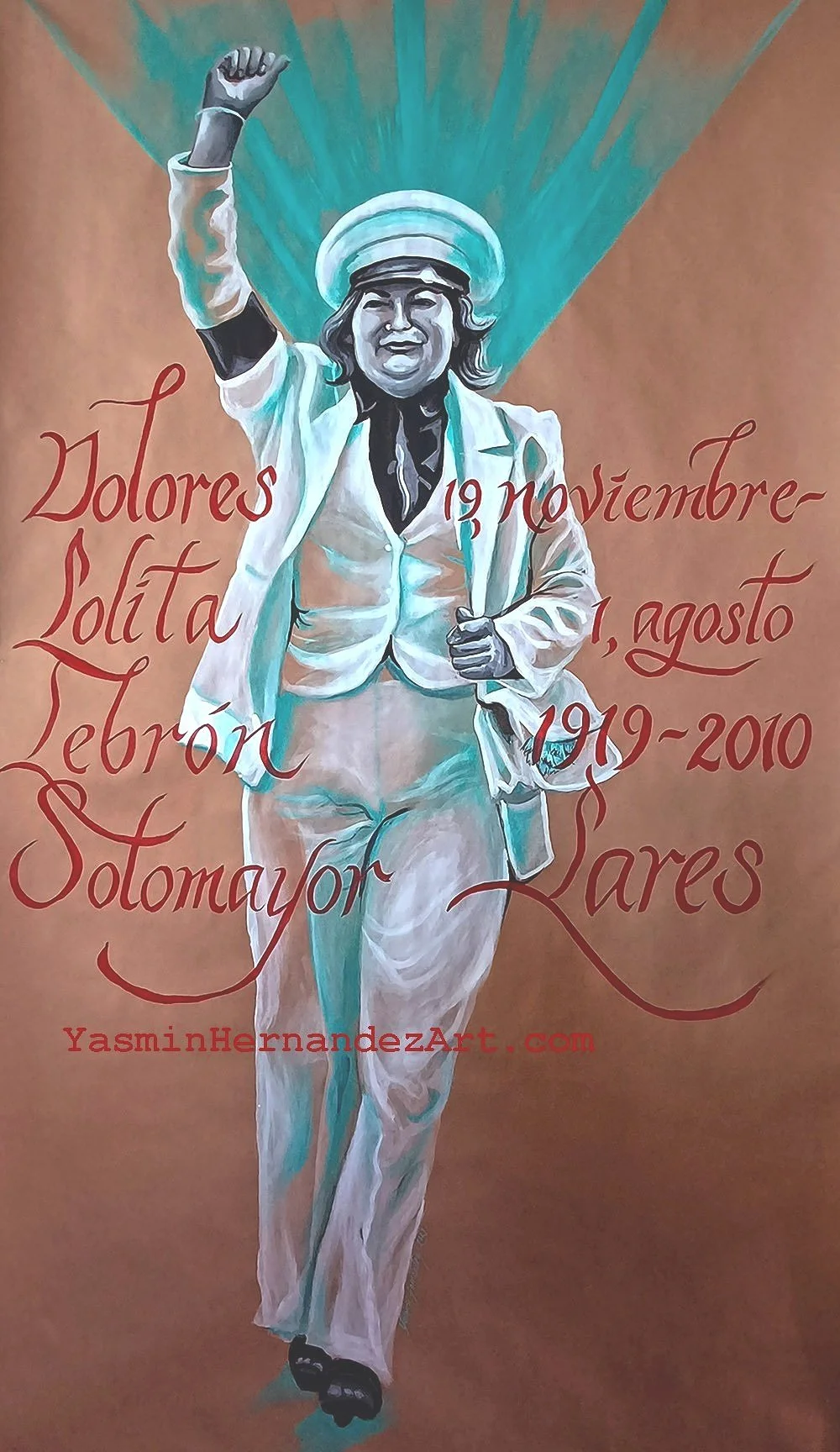
"Soldadera: Lolita Lebron:" 2021, Acrylic on Brown Paper, 55”x36”. Contemplating ten years since my Soldaderas mural, I began this series of women fighting continued US imperialism. Lolita Lebrón Sotomayor was born on November 19, historic day of Columbus’ 1493 landing. Born in the mountain town of Lares, site of the 1868 revolution, she was destined to be a Soldadera. A member of the Puerto Rican Nationalist Party, Lolita is most known for leading an armed revolt at the US Capitol on March 1st, 1954, for which she was held for 25 years as a Political Prisoner of the US on sedition charges.
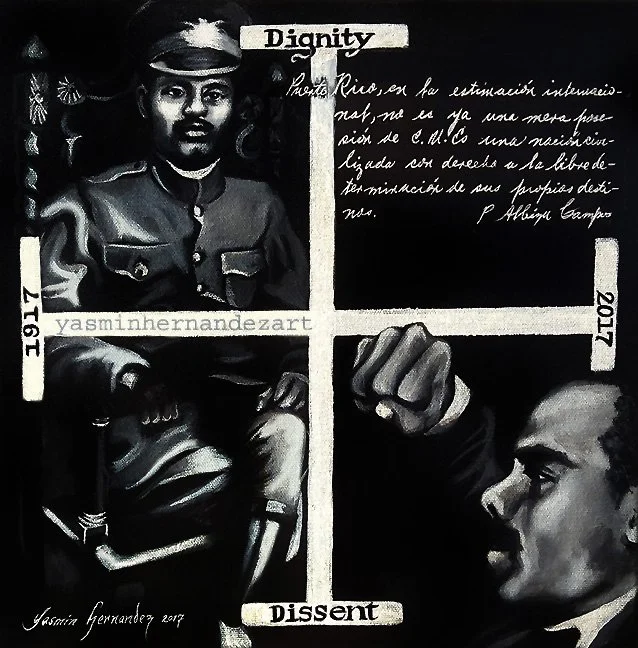
"Dignity/ Dissent" (Pedro Albizu Campos) 2017, Yasmin Hernandez. Acrylic on canvas, 12" x 12". Created for the CitiCien Defend PR exhibition, commemorating 100 years of the Jones Act that imposed US citizenship on Puerto Rico, strategically the same year the US entered WWI, enabling the draft of our men. Nationalist Party leader Pedro Albizu Campos is pictured here in his US Army uniform that same year and later in a gesture representing his fierce fight against US colonialism. The background image in black and white is of the Puerto Rican Nationalist Party flag.

"La Libertad" (Oscar López Rivera) 2016. Yasmin Hernandez. Mixed media on canvas, 24" x 36". Created for the traveling exhibition, Una Sola Voz which brought together over 50 artists in support of the release of Puerto Rican Political Prisoner Oscar Lopez Rivera, pictured here among many other heroes that have defended Puerto Rico's natural right to liberation. Included is an excerpt of our original revolutionary anthem, La Borinqueña by Lola Rodríguez de Tío. "Vamonos ya que nos espera ansiosa la Libertad".
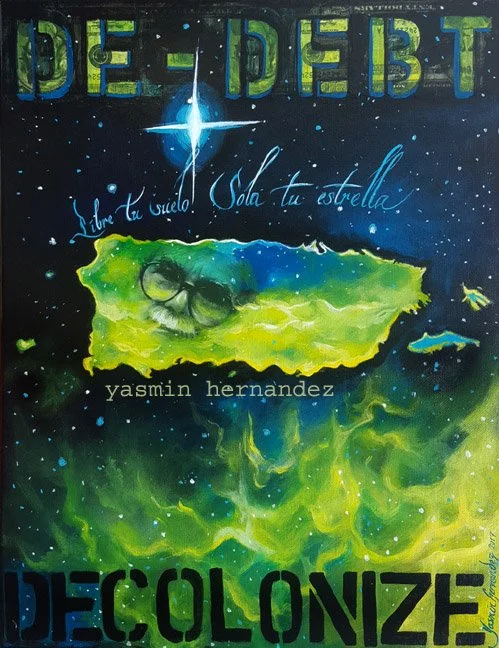
"Dedebt/ Decolonize" 2017. Yasmin Hernandez. Mixed media on canvas, 18" x 14". Commissioned for Occupy Museum’s Debt Fair installation at the 2017 Whitney Biennial. The Puerto Rican archipelago is presented within a nebula. From the main island emerges the face of Oscar López Rivera, held as a Political Prisoner of the US for 35 years on sedition charges for participating in the Puerto Rican liberation struggle. His sentence was commuted by US President Obama 1 week after I completed this work. The work was still on exhibit at the Whitney when Oscar was released in May of 2017.

"Eso que llamamos la libertad", 2016. Yasmin Hernandez. Acrylic on canvas, 30" x 24". Portrait of artist, poet, professor, former Puerto Rican political prisoner Elizam Escobar. I included a quote I heard during his presentation at a political prisoner conference in Mayagüez: "That which we call freedom is not a state of being, it is a practice." I painted him dressed in a nebula to reference the transcendence and liberatory practice embodied by Elizam in his art, actions, and words. Elizam left this realm in January of 2021.

“Las Cuatro Esquinas” 2016. Yasmin Hernandez. Acrylic on recycled palette wood. Detail of collaborative installation at the former Galería Betances, Mayagüez, PR. This image was part of a tribute exhibition to 19th century Puerto Rican Revolutionary, Abolitionist, Dr. Ramón Emeterio Betances. It includes a recreation of the Lares flag that he designed for the September 23rd, 1868 revolution that he authored representations of enslaved people who were emancipated on March 22nd, 1873, thanks to his abolition work.

"Esas estrellas" 2015. Yasmin Hernandez. 2015, Acrylic on burlap, approx 30" x 39" Tribute to Rafael Cancel Miranda, former political prisoner who served 25 years on sedition charges for his participation in an armed revolt in Washington DC in 1954. The quote comes from the dedication of his book, Mis Dioses llevan tu Nombre (2000). “Hay estrellas en el cielo que no vemos porque no las buscamos. La razón de este libro es ayudar a encontrar a esas estrellas en nuestros propios cielos.” (There are stars in the sky that we do not see because we do not seek them. The reason for this book is to help find those stars in our own skies.)

"Somos Muchos" (Oscar López Rivera) Yasmin Hernandez. 2015, Mixed media on canvas, 30" x 24". Commissioned for the University of Puerto Rico-Mayagüez’ conference, Luchas de Ayer, Ahora y Siempre (?) on Puerto Rican political prisoners past and present. Oscar López Rivera is presented among a selection of ancestors who sacrificed their lives for the liberation of Puerto Rico. Within his portrait we see a selection of the comrades who, like him, have served as political prisoners for wanting the freedom of their country.

“Quienes Somos/ Who we are”. Superimposed over the "Somos Muchos" painting are the names of all the Puerto Rican freedom fighters collaged into this portrait of former Puerto Rican political prisoner of 35 years, Oscar López Rivera.

"Querer ser libre" (Dylcia Pagán) 2006. Yasmin Hernandez. Acrylic, seashells and peacock feathers on canvas. 24" x 36". This portrait was commissioned for a tribute to former Puerto Rican political prisoner Dylcia Pagán by the Bronx Academy of Arts and Dance (BAAD). My dear friend and mentor, I painted her as I remembered during an afternoon we spent at the sea, behind her home in Loíza. This portrait hung in her living room until her unexpected transition into ancestorhood in 2024. The quote is of Ramón Emeterio Betances, (The desire to be free is to begin being free). I am ever grateful to the freedom she embodied and modelled for us all and to the fierce love she shined on me and so many of my generation, and beyond.

"Raising Revolution" 2004, (Pedro Albizu Campos). Yasmin Hernandez. Mixed media on canvas, 48" x 30" Collection of the Center for Puerto Rican Studies. This portrait of Pedro Albizu Campos shows him in his US Army uniform, but the piece itself focuses on many revolutionaries who received their training in either the US military or US schools. Puerto Ricans were made citizens of the US in 1917, strategically the year the US entered WWI. However, as a colony, Puerto Rico cannot vote in presidential elections, having no say in the commander of chief of the many who serve the US armed forces. Many have subverted this military training, using it instead to inform their liberation work.
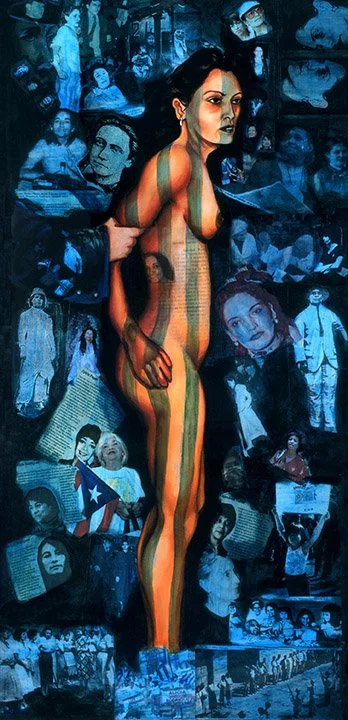
"Pesar y orgullo" 2004. Yasmin Hernandez. Mixed media on canvas, 48" x 24". This portrait of Puerto Rican Nationalist Lolita Lebrón shows her at the time of her arrest having led an armed protest at the US Capitol on March 1, 1954. She is nude with prison bars glazed over her flesh, marking the double standard imposed on women revolutionaries and the violation of their bodies as political prisoners. The collage features revolutionary women of color. This piece was in response to the 2004 Washington Post Magazine article with Lolita’s image on the cover and the title: When Terror Wore Lipstick. I was asked to contribute artwork to that article. I asked for assurance that she would not be presented in a negative light then was mortified when it was published with that cover. In a public chat with the author, people criticized Lolita for abandoning her children, making references to domestic responsibilities that male revolutionaries are never challenged on. With this work, I contemplated her body as a cell, a site of oppression that the empire wages violence on.

"Sin Miedo" (Para Lolita). 2003. Yasmin Hernandez. Acrylic on canvas, 36" x 18". Collection of Poet/ Author Luivette Resto. This is another portrait of a fearless Lolita Lebrón at the time of her arrest on March 1, 1954 after leading an armed protest over a meeting of the US House of Representatives, demanding a Free Puerto Rico. Lolita & her comrades served 25 years before US President Jimmy Carter (the most honest US president) commuted their sentences in 1979.

"Albizu Elevao." 2006. Yasmin Hernandez. Acrylic on Burlap, 72" x 39 1/2". “Ay como lo escupieron/ Como lo empujaron/ Como lo llevaron a crucificar....” -excerpt from the salsa song "El Todopoderoso" (Oh how they spit on him, how they pushed him, how they took him to crucifixion). This work references the radiation experiments that the US government conducted on the father of Puerto Rican Nationalism Pedro Albizu Campos. These were secretly administered in the form of bright white or multicolored lights that would flash in his cell & in his hospital room. Albizu suffered burns & seizures, ultimately passing from cancer in 1965. Albizu had exposed US Dr. Cornelius Rhoads who had deliberately injected cancer into Puerto Ricans. For this and other cancer and chemical experiments he conducted in the US prison system, Dr. Rhoads was named Time Magazine’s “Man of the Year” and became director of the Rockefeller Institute and the Memorial Sloan Kettering Cancer Center in New York.

“Patria Ensangrentada” (Filiberto Ojeda Ríos). 2006. Yasmin Hernandez. Acrylic on canvas, 63" x 40". Patria Ensangrentada pero jamás desecha. (Nation bloodied, but never undone). These words of Puerto Rican Nationalist poet Julia de Burgos come from her poem”23 de septiembre,” about the 1868 Lares revolution. On the same date in 2005, the FBI assassinated revolutionary leader of Los Macheteros, Filiberto Ojeda Rios, who had been in clandestinity for 15 years. 72 years-old at the time, he solely held a shoot-out with them wearing a bullet proof vest, but was left to bleed to death behind his front door from a single bullet to his clavicle, something he should have survived. The town had been under siege in the planned attack on his home in Hormigueros. No ambulances were allowed to pass.

“Independence Day,” 1998. Yasmin Hernandez. Mixed media on canvas, 6' x 4'. Created for the AmeRican Borders centennial of the US invasion of Puerto Rico exhibition at Taller Puertorriqueño in Philadelphia. This scene depicts the arrests of the 4 Puerto Rican Nationalists outside of the US capitol on March 1st, 1954, with a Puerto Rican flag glazed over the building. The background is an inverted copy of the US Constitution & the foreground, which they stand on, is an inverted copy of the US Declaration of Independence. I lived 5 blocks from Independence Hall in Philly at the time. Almost ten years after painting this, while researching the ARCHIVOS SUBVERSIVOS project at the Center for Puerto Rican Studies, I found a letter that Albizu Campos wrote to his friend Ruth Reynolds, on a torn out page of the Table of Contents of the US Constitution.

Follow the Leader, 1998 (Pedro Albizu Campos). Yasmin Hernandez. Oil on canvas, 30" x 24". Living and working in Philadelphia during the centennial, I contemplated the invasion of my nation within sites like the Liberty Belly, altars to the independence of the imperialist. I began envisioning altars to our own liberation. This piece is born from that envisioning. The title always reminds me of the rap "Follow the Leader" by Rakim (...Remember, you're not a slave 'Cause we was put here to be much more than that/ But we couldn't see it because our mind was trapped.) I returned to New York in 1999 during the escalation of the movements for peace and justice on Vieques and the excarceration of our Puerto Rican Political Prisoners.

“The Ponce Massacre”, 1997. Yasmin Hernandez. Oil, collage on canvas, 51" x 34". Part of my BFA Thesis exhibition at Cornell University, created in the underpainting/ glaze technique, this image borrows from the composition of Paul Revere's “The Bloody Massacre” of 1770, depicting the Boston Massacre leading to the American Revolution. The Ponce Massacre, took place on March 21st, 1937 in my parents' hometown, when the US colonial police chief revoked a parade permit on Palm Sunday commemorating the abolition of slavery. When the people marched anyway, the police opened fire on them killing 21 & wounding around 200.
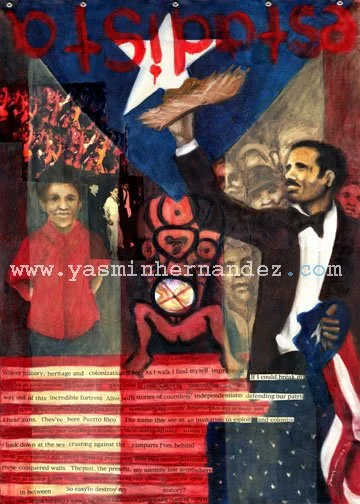
“¿Estadista?” 1996. Yasmin Hernandez. Mixed media on canvas, 48" x 32". This is one of various flags painted on canvas with grommets. The indigenous figure of Atabey and the fetus reference the mass sterilization of Puerto Rican women. Albizu and the group of striking laborers are juxtaposed with images of the Latin Kings. As I embarked on a self-education process on our subversive history as an undergrad at the libraries of Cornell University, my cousin and uncle did the same with The Latin Kings and the Ñetas while incarcerated. This piece honors our diverse paths towards decolonization and denounces statehood as something that impedes that process.

“51st State”, 1995. Yasmin Hernandez. Oil on canvas. 48" x 37 1/2". Painted during my junior year/ BFA program at Cornell University. 51st State is technically my first portrait of the 4 Nationalists arrested in Washington on March 1st, 1954. Lolita Lebrón is the star and Rafael Cancel Miranda, Irving Flores, and Andres Figueroa Cordero are the rifles. Together they dissolve the colonial relationship of Puerto Rico and the US, hence the falling stars and the Navy blue of both flags. My earlier political works use the dark blue of the US flag and over time lighten to the sky blue used by independence supporters. The original concept of our flag, designed as an inverse of the Cuban flag in New York in the 1890s via the Puerto Rican Wing of the Cuban Revolutionary Party references the sky in its inspiration. After the 1898 invasion, our flag was darkened to resemble that of the US.

“Pedro Albizu Campos,” 1994. Yasmin Hernandez. Silkscreen on Paper, 14" x 8". This first portrait of mine of Pedro Albizu Campos was inspired by the book Prisoners of Colonialism by Ronald Fernandez. I was 19 and eagerly researching all things Don Pedro. My practice of painting in response to my self-education around suppressed Puerto Rican histories began in high school, however my introduction to this history didn’t begin with books but with the oral histories of my father. Black and white are the colors of the Puerto Rican Nationalist Party.